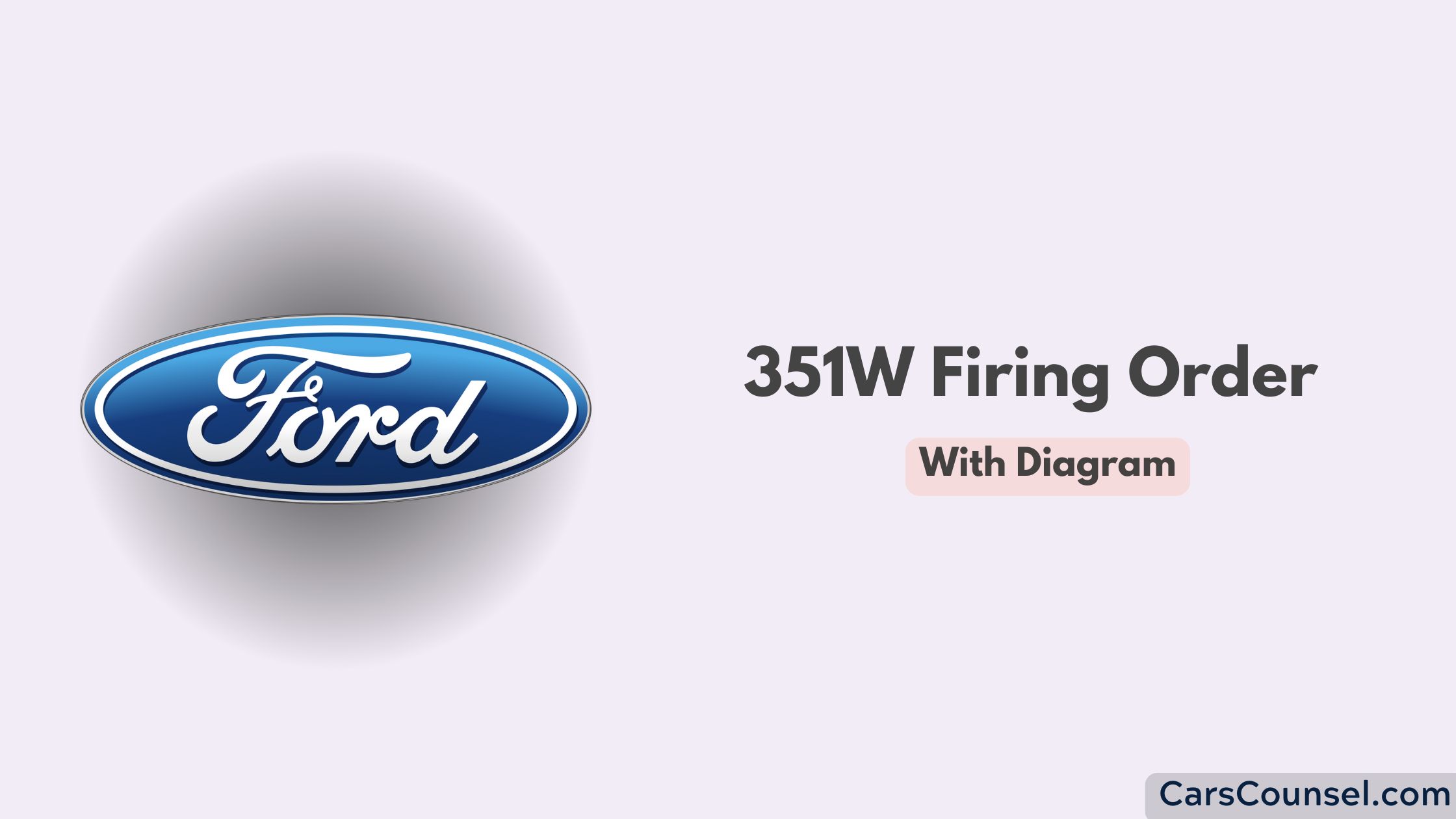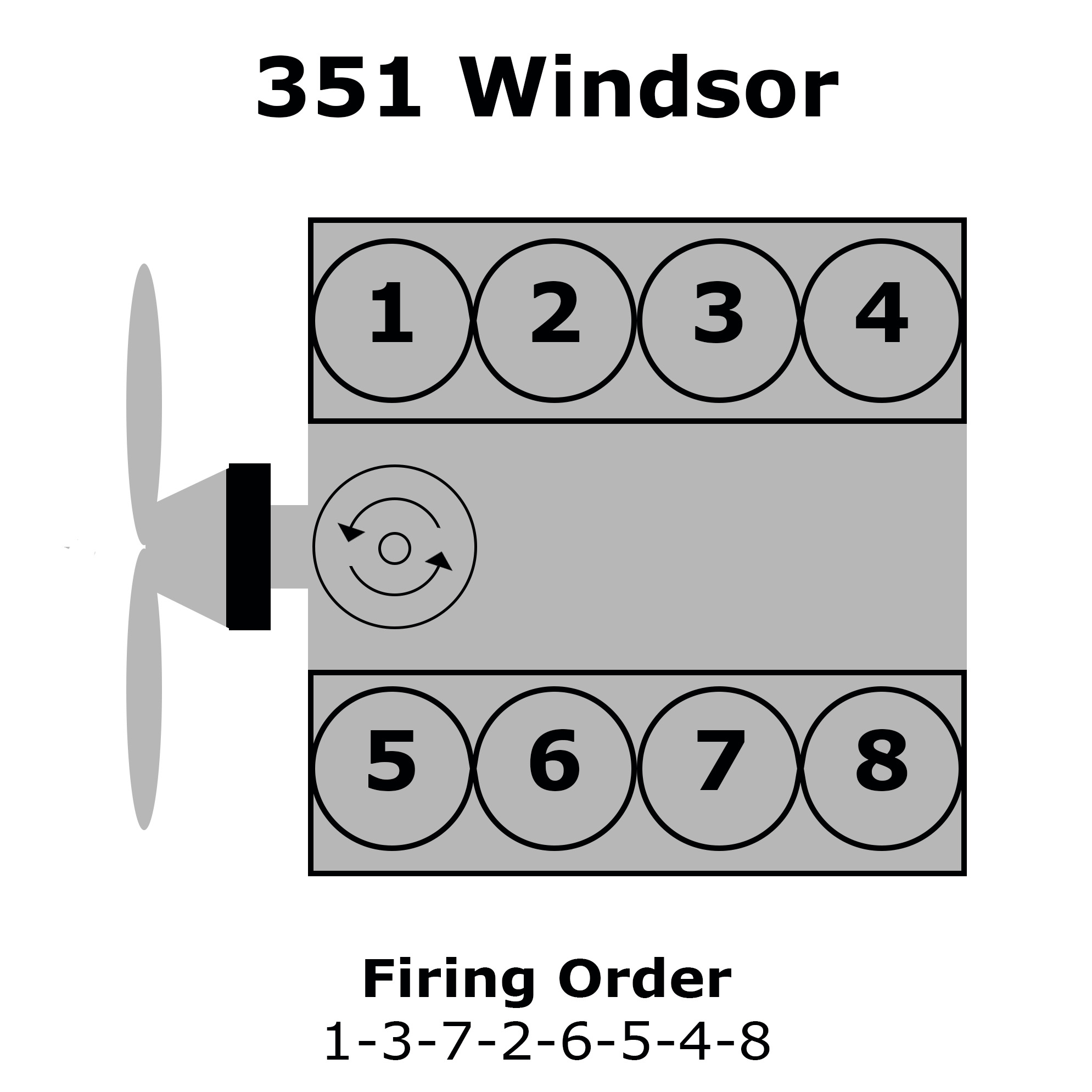The 351W firing order is an essential topic for anyone working on Ford’s small-block Windsor V8 engine. Getting it right ensures optimal engine performance, smooth operation, and longevity. This article simplifies the technicalities, explaining the critical details in a conversational yet informative tone.

Quick Navigation
351W Firing Order
The 351W firing order, unlike earlier Ford small-blocks, differs slightly to improve performance and balance.
The firing sequence for the 351W is as follows: 1-3-7-2-6-5-4-8.

This sequence fires the cylinders in a way that reduces engine vibrations and balances power delivery.
What is a Firing Order?
The firing order defines the sequence in which the spark plugs ignite the air-fuel mixture in each cylinder. This sequence determines how the engine generates power. Incorrect firing orders can cause misfires, loss of power, or even engine damage.
Overview of the 351W Engine
The 351W engine, introduced by Ford in 1969, belongs to the Windsor family of small-block V8s. This engine gained popularity due to its reliability, high performance, and adaptability for various applications, from muscle cars to trucks.
Key Specifications
- Engine Type: Overhead valve V8
- Displacement: 5.8L (351 cubic inches)
- Cylinder Layout: V8
- Standard Firing Order: 1-3-7-2-6-5-4-8
Cylinder Numbering
The cylinders on the 351W are numbered as follows:
- Driver’s Side (Front to Back): 1, 2, 3, 4
- Passenger’s Side (Front to Back): 5, 6, 7, 8
Why It Matters
- Balanced Power: The order ensures even power strokes across the crankshaft.
- Reduced Vibrations: Proper sequencing minimizes stress on engine components.
How to Identify the Firing Order
Steps to Determine the Firing Order
- Locate the Distributor Cap: The cap holds the ignition wire terminals for each cylinder.
- Identify Cylinder #1: Usually marked on the distributor or referenced in the owner’s manual.
- Trace the Order: Follow the wires clockwise or counterclockwise based on the engine design.
- Consult a Diagram: Use the engine’s specific firing order diagram to confirm connections.
Distributor Rotation
The 351W distributor rotates counterclockwise. Spark plug wires must connect to the distributor in the correct sequence to match the firing order.
Differences Between 351W and Other Ford Engines
The 351W firing order stands apart from other small-block Ford engines like the 289 and 302. Those engines use a 1-5-4-2-6-3-7-8 firing order. Mixing up these sequences can cause significant issues.
Symptoms of Incorrect Firing Order
An incorrect firing order causes:
- Engine Misfires: Cylinders fail to ignite properly.
- Backfiring: Fuel ignites outside the combustion chamber.
- Loss of Power: Improper sequencing disrupts power delivery.
- Rough Idling: The engine vibrates excessively.
- Hard Starting: Difficulty starting the engine.
Setting the Firing Order: Practical Guide
Tools Required
- Socket wrench
- Timing light
- Distributor wrench
- Spark plug gap tool
- Engine manual
Steps
- Disconnect the Battery: Safety first—avoid accidental sparks.
- Locate Cylinder #1: Check the manual for precise positioning.
- Align the Timing Marks: Rotate the crankshaft to the top dead center (TDC) on the compression stroke for Cylinder #1.
- Position the Distributor: Install the distributor with the rotor pointing to the #1 terminal.
- Connect Spark Plug Wires: Attach wires following the 1-3-7-2-6-5-4-8 sequence.
- Verify with a Timing Light: Ensure ignition timing aligns with the manufacturer’s specs.
Troubleshooting Firing Order Issues
If your engine runs poorly after setting the firing order:
- Double-check Wiring: Verify the connections match the 351W sequence.
- Inspect the Distributor: Ensure proper alignment at TDC.
- Test Spark Plugs: Check for fouling or incorrect gaps.
- Examine Timing Marks: Confirm the crankshaft and camshaft alignment.
Performance Impact of Correct Firing Order
A correct firing order enhances:
- Fuel Efficiency: Precise ignition maximizes combustion.
- Engine Longevity: Reduced stress prevents premature wear.
- Smooth Operation: Balanced power strokes improve ride quality.
- Performance Tuning: Critical for aftermarket upgrades.
Upgrading the 351W for Modern Performance
The 351W remains popular for performance builds. When modifying, consider:
- Aftermarket Ignition Systems: Upgraded distributors and coils improve spark delivery.
- High-Performance Cams: Ensure compatibility with the firing order.
- Electronic Ignition Conversion: Eliminates points for modern reliability.
Engines with Similar Firing Orders
- 429 Ford Firing Order
- 2010 Ford Edge Firing Order
- Ford XG Falcon Firing Order
- Ford XF Falcon Firing Order
- 351M Firing Order
Frequently Asked Questions
Can the 351W use the 302 firing order?
No, the 302 and 351W use different camshafts. Swapping firing orders requires a compatible camshaft.
What happens if I mix up spark plug wires?
Incorrect wiring disrupts the firing order, causing misfires or engine failure.
How can I verify the firing order is correct?
Run the engine and listen for smooth operation. Use a timing light to confirm ignition timing.
Conclusion
The 351W firing order plays a critical role in the engine’s performance and reliability. Following the correct sequence (1-3-7-2-6-5-4-8) ensures smooth operation and longevity. Whether you’re performing maintenance or building a performance engine, understanding and applying this knowledge is key.


Under Cylinder Numbering you’ve miss labeled the Drivers Side and Passenger Side numbering.